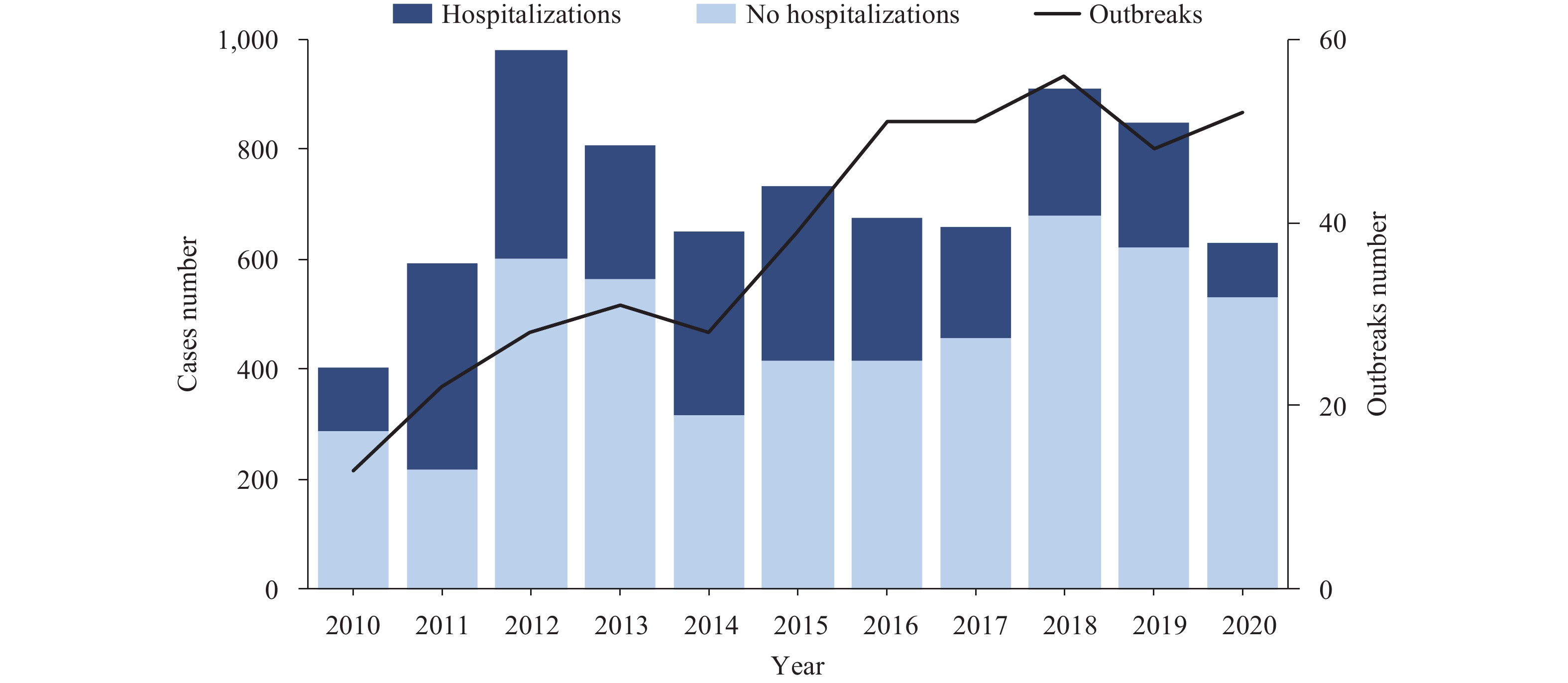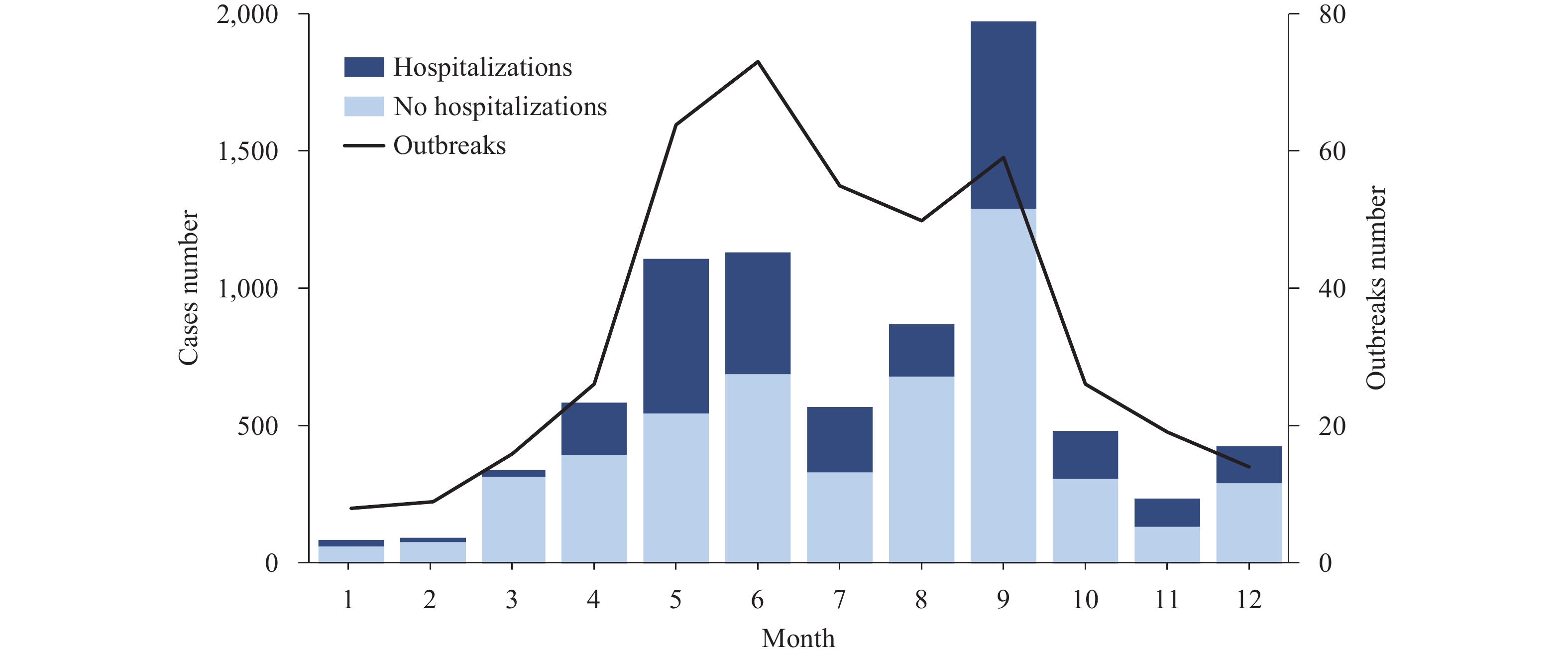-
Bacillus cereus(B. cereus)frequently contaminates food and functions as an opportunistic pathogen, leading to outbreaks of foodborne diseases (1-2). Over the past decade in China, it ranks as the fourth leading bacterial pathogen associated with foodborne outbreaks (3).B. cereusproduces a spectrum of toxins that can be primarily classified into vomiting-type and diarrhea-type enterotoxins based on symptoms they cause (4-5). Its foodborne infections manifest as severe symptoms, such as nausea, vomiting, and diarrhea; in some instances, it can be fatal and typically presents sudden onset (6-8). Consequently, the results of our analysis can be efficiently utilized to direct and allocate public health resources to mitigateB. cereusassociated foodborne diseases.
-
Between 2010 and 2020, the National Foodborne Disease Outbreak Surveillance System was used by all sectors of CDC to document incidents of foodborne outbreaks. This study specifically collected data on outbreaks caused byB. cereus. Required data for each outbreak comprised of date of occurrence, geographical region, case count, number of hospitalizations and deaths, setting for food preparation, etiologic agents, and implicated food, among other factors. The population statistics were derived from the seventh national census conducted in 2020.
The National Foodborne Disease Outbreaks Surveillance System processed and disseminated all monitoring data. Data cleansing and database creation were carried out using Microsoft Office (version 2010, Microsoft, Washington, USA), while SPSS (version 16.0, SPSS Inc, Chicago, USA) was employed for the related statistical analysis.
Correlational definitions:
An outbreak of foodborne illness is cited when two or more cases of the disease are documented.
The term “multifactor” is employed to represent the simultaneous presence of two or more elements of food contamination. These elements may include improper storage, contamination or spoilage of ingredients, cross-contamination between raw and cooked foods, and food expiration among others.
-
Between 2010 and 2020, we documented a total of 419 foodborne outbreaks attributed toB. cereus, resulting in 7,892 cases, 2,786 hospital admissions, and 5 fatalities.
Figure 1illustrates the distribution of outbreak cases over a decade. In 2018, out of all reported outbreaks, 56 instances, constituting 13.37%, were noted, marking the highest count from 2010 to 2020. Notably, the year 2012 reported the most cases, with a sum of 979, constituting 12.40% of all instances. However, the year 2011 recorded the peak for hospitalization rate. The period from 2014 to 2016 experienced five fatalities: one in 2014, two in 2015, and the remaining two in 2016.
 Figure 1.
Figure 1.Annual distribution of foodborne outbreaks, instances, and hospitalizations attributed toB. cereusin China from 2010 to 2020.
The frequency of reported outbreaks varied on a monthly basis (Figure 2), predominantly occurring between May and September. In June, 73 outbreaks were noted, comprising 17.42% of the total outbreaks. The peak in the number of cases was observed in September, with 1,975 cases recorded, affecting the greatest number of individuals (25.01%). The month of May reported the highest rate of hospitalizations (51.04%). Mortalities were relatively low, with two reported in February and one each in April, July, and August.
 Figure 2.
Figure 2.Monthly distribution of foodborne outbreaks, cases, and hospitalizations resulting fromB. cereusin China from 2010 to 2020.
The data highlighted notable differences in the proportion of outbreak cases attributed to various food sources (Table 1). Foods derived from rice or flour were identified as the primary cause of most outbreaks (46.30%) and associated cases (40.81%). Bakery products were responsible for the highest hospitalization rate (67.78%). Furthermore, five mortalities were chiefly associated with rice or flour-based products and complex foods.
Food category Outbreaks Cases Hospitalizations Deaths Number Proportion (%)§ Number Proportion (%)¶ Number Rate (%)** Number Fatality rate (%)†† Rice or flour 194 46.30 3,221 40.81 1,230 38.19 3 0.09 Complex food* 54 12.89 1,430 18.12 347 24.27 2 0.14 Multiple food† 51 12.17 1,174 14.88 353 30.07 0 0.00 Meat 29 6.92 398 5.04 251 63.07 0 0.00 Bean 21 5.01 630 7.98 275 43.65 0 0.00 Vegetable 17 4.06 237 3.00 68 28.69 0 0.00 Pastry 14 3.34 239 3.03 162 67.78 0 0.00 Aquatic animal 8 1.91 125 1.58 44 35.20 0 0.00 Beverage and frozen drink 5 1.19 57 0.72 11 19.30 0 0.00 Dairy 3 0.72 93 1.18 9 9.68 0 0.00 Fruit 2 0.48 26 0.33 0 0.00 0 0.00 Egg 2 0.48 8 0.10 0 0.00 0 0.00 Condiment 2 0.48 6 0.08 3 50.00 0 0.00 Other food 3 0.72 31 0.39 19 61.29 0 0.00 Unknown food 14 3.34 217 2.75 14 6.45 0 0.00 Total 419 100.00 7,892 100.00 2,786 35.30 5 0.06 * Complex food: These are items that contain multiple components, but the specific ingredient causing the outbreak cannot be accurately identified.
†Multiple food: The causative agent originates from diverse food categories.
§Proportion (%)=Outbreaks number/Total number×100%.
¶Proportion (%)=Cases number/Total number×100%.
**Rate (%)=Hospitalizations number/Cases number×100%.
††Fatality rate(%)=Deaths number/Cases number×100%.Table 1.Number and proportion ofB. cereusfoodborne outbreaks, incidents, hospitalization cases, and deaths organized by food category in China from 2010 to 2020.
Upon conducting further analysis of each category of rice or flour products implicated in foodborne outbreaks associated withB. cereus, it was found that rice and rice products accounted for a higher number of outbreaks (158 outbreaks), compared to flour and flour products (36 outbreaks).
The number of outbreak instances was subject to variation based on the location of food preparation, as outlined inFigure 3. The primary source of these outbreaks, as well as the related cases, was found to be school cafeterias. In fact, 26.25% of outbreaks could be traced back to food prepared in these school canteens, accounting for 48.34% of cases associated with such outbreaks. However, the household held the record for the highest hospitalization rate at 53.92%, along with the highest mortality rate at 1.37%.
 Figure 3.
Figure 3.Distribution of foodborne outbreaks, cases, and hospitalizations caused byB. cereusin various settings in China from 2010–2020.
Multifactor contamination was identified as the cause for 39.14% of outbreaks and 41.02% of associated cases. This was closely followed by improper storage, accounting for 111 outbreaks (26.49%) and 1,981 cases (25.10%). The highest rate of hospitalization was attributed to food mishandling and ingestion errors, which stood at 71.93%. Moreover, two out of the reported five fatalities were due to undetermined causes.
In the multifactor composition, the occurrence of two factors was most prevalent, accounting for 70.12% of the cases. Conversely, instances involving more than two factors represented 29.88% of the cases. Of the pairings in the two-factor configuration, the most frequent combination, comprising 48.78%, was inadequate storage and inappropriate processing. Meanwhile, the combination of ingredient contamination or spoilage with improper storage made up 9.76%. For configurations involving more than two factors, the most common trio was ingredient contamination or spoilage, inappropriate storage, and improper processing, which accounted for 53.33% of such cases.
-
From 2010 to 2020, microbial agents notably contributed to the incidence of foodborne disease outbreaks in China. These microbial outbreak cases were second only to mushroom poisoning in regards to the number of cases reported. This pattern supports previous studies (9), withB. cereusranking fourth among factors associated with microbial foodborne disease outbreaks. However, the fatality rate associated withB. cereuswas significantly higher compared to other contributing factors. Thus, increased vigilance towards outbreaks ofB. cereusis highly recommended for relevant departments.
Between 2010 and 2016, China experienced a gradual increase inB. cereus-related outbreaks, which subsequently stabilized to approximately 50 outbreaks annually over the subsequent five years. Remarkably, 2018 saw the highest number of these reported outbreaks. The majority of these foodborne diseases related toB. cereustypically occurred between May and September, demonstrating a certain level of annual consistency. Notably, the majority of these incidents were reported during the summer, followed by the spring and fall. Attributable to its optimal growth temperature (28–35 °C),B. cereushas the potential to proliferate rapidly and generate substantial quantities of toxins, thereby inducing foodborne cases, according to a previous study (2). This trend substantiates that theB. cereuspoisoning peak season is typically the summer. Domestic and international studies (10-11) further reveal that the most pathogenic food inB. cereusoutbreaks is primarily rice or flour products, representing nearly half of all categories. Moreover, the proportion of rice and rice products in all types of rice or flour products exceeds 80%. Further breakdown showed that rice and fried rice constituted 36% and 33% within the category of rice and rice products, respectively.
School canteens and households appeared most frequently as sources of food preparation connected toB. cereusoutbreaks. Nevertheless, the number of instances linked to food prepared in school canteens was markedly greater than those connected to households, constituting nearly half of all affected cases. Given the difficulties students face in discerning food quality and the inherent nature of communal dining in schools, they are at a heightened risk for foodborne disease outbreaks. Therefore, to mitigate the frequency of such outbreaks, supervisory bodies should enhance their oversight and management of food safety in school canteens.
Food contamination is influenced by a myriad of complex factors. Our findings are consistent with prior research (12-13), revealing that the simultaneous or interactive presence of several factors is most often the cause of food contamination. For instance, improper handling, excessive propagation, and subsequent toxin secretion due to inadequate preservation can result in contamination byB. cereus. To mitigate the risk of foodborne outbreaks attributed toB. cereus, it is essential to address a multitude of core control and management factors. These include utilizing safe food ingredients, ensuring cleanliness and standardization throughout the food processing procedure, preventing cross-contamination, thoroughly cooking the food, among others. Concurrently, implementing proper preservation to inhibit the growth ofB. cereusis of great significance.
This study focuses solely on outbreaks investigated by the China CDC, which may not accurately reflect the true incidence. Monitoring foodborne disease outbreaks is a multifaceted endeavor necessitating government support, swift diagnosis from medical institutions, thorough food hygiene assessments by the Market Supervision and Administration Department, diligent epidemiological inquiry by the CDC, and exact laboratory testing.
-
All members of all participating CDCs.
-
No conflicts of interest.
HTML
| Citation: |




 Download:
Download:






